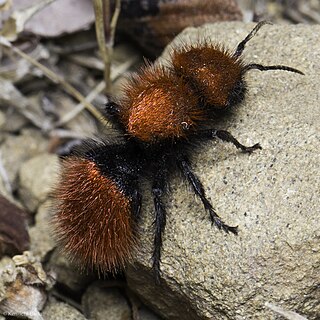
Convolvulaceae, commonly called the bindweeds or morning glories, is a family of about 60 genera and more than 1,650 species. These species are primarily herbaceous vines, but also include trees, shrubs and herbs. The tubers of several species are edible, the best known of which is the sweet potato.

Carl Robert Osten-Sacken or Carl-Robert Romanovich, Baron von der Osten-Sacken, Baron Osten Sacken was a German-Russian diplomat and entomologist. He served as the Russian consul general in New York City during the American Civil War, living in the United States from 1856 to 1877. He worked on the taxonomy of flies in general and particularly of the family Tipulidae.

Nemestrinidae, or tangle-veined flies is a family of flies in the superfamily Nemestrinoidea, closely related to Acroceridae. The family is small but distributed worldwide, with about 300 species in 34 genera. Larvae are endoparasitoids of either grasshoppers (Trichopsideinae) or scarab beetles (Hirmoneurinae). Some are considered important in the control of grasshopper populations. Adults are often observed on flowers.

Dasymutilla is a wasp genus belonging to the family Mutillidae. Their larvae are external parasites to various types of ground-nesting Hymenoptera. Most of the velvet ants in North America—the wingless females of which are conspicuous as colorful, fast, and "fuzzy" bugs—are in the genus Dasymutilla.

The southern ribbon snake(Thamnophis saurita sackenii), also known commonly as the peninsula ribbon snake and the Florida ribbon snake, is a subspecies of garter snake in the family Colubridae. It is one of four subspecies of the ribbon snake.

Pelecorhynchidae is a small family of flies. All of the genera were originally placed in the family Rhagionidae, and their elevation to family rank has been controversial. Other phylogenetic analyses have supported Pelecorhynchidae as a distinct clade from Rhagionidae. The adults of Pelecorhynchus mostly feed on nectar of Leptospermum flowers. Larvae have been collected in the damp margins of swamp areas, where they feed on earthworms.
Conophorus is a genus of bee flies in the family Bombyliidae. There are at least 16 described species in Conophorus in the United States, and 67 total worldwide.
Neorhynchocephalus volaticus is a species of tangle-veined fly in the family Nemestrinidae.

Neorhynchocephalus is a genus of tangle-veined flies in the family Nemestrinidae.
Mallota bequaerti is a species of syrphid fly in the family Syrphidae.
Aradus acutus is a species of flat bug in the family Aradidae. It is found in North America.
Aneurus borealis is a species of flat bug in the family Aradidae. It is found in North America.
Gozmanyina majestus is a species of cosmochthoniid in the family Cosmochthoniidae.

Chimarra is a genus of little black caddisflies in the family Philopotamidae. There are more than 630 described species in Chimarra.
Mezira pacifica is a species of flat bug in the family Aradidae. It is found in North America.
Exochocepheus eremitus is a species of mite in the family Scutoverticidae.
Bittacomorphella is a genus of pygmy phantom crane flies in the family Ptychopteridae. There are about 11 described species in Bittacomorphella.
Conophorus sackenii is a species of bee fly in the family Bombyliidae.

Dasymutilla sackenii, also known as Sacken's velvet ant, is a species of velvet ant, actually a type of wasp. It is found in Oregon, California, Nevada, Baja California, and Baja California Sur. As with most velvet ants, the males have wings and the females are wingless. The females of this species have cream-colored fuzz (setae) on their backs and black fuzz on their ventral side and legs. D. sackenii is most commonly observed May through October; observations December through February are very rare.

Dasymutilla satanas, also known as Satan's velvet ant, is a species of velvet ant found in the deserts of the Great Basin region of North America. The name is most likely a reference to the "hellish" deserts where it dwells. The females of this species are relatively large for the genus, comparable to the size of Dasymutilla magna or Dasymutilla sackenii females.










